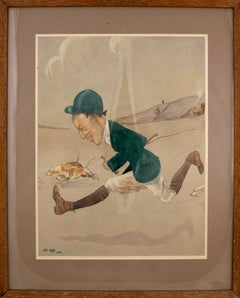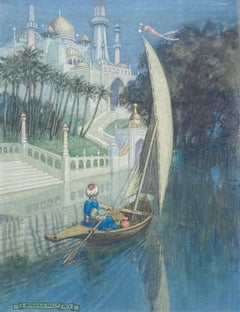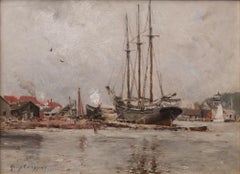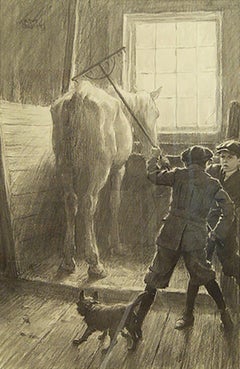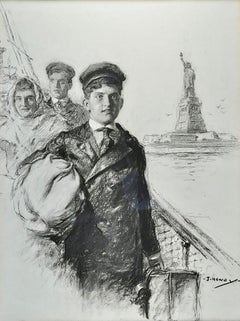1910s Art
to
327
1,100
351
373
172
164
Overall Width
to
Overall Height
to
7,561
20,977
156,468
235,153
1,865
2,212
4,760
6,452
5,811
13,007
19,553
25,067
17,302
13,339
5,326
425
302
136
123
45
18
17
6
5
1
1,206
857
30
1,422
700
586
426
389
355
219
146
136
136
133
121
117
99
87
83
80
75
55
54
806
571
459
389
352
101
47
34
24
22
795
361
1,176
907
Period: 1910s
"Beagling" 1914 Watercolour
Located in Bristol, CT
Watercolour depicting a hunter green coat'd beagler running with his pack across the countryside.
Signed: Wil Mots 1914
Art Sz: 11 3/8"H x 8 5/8"W
Frame Sz: 16"H x 13"W
Category
1910s Art
Materials
Watercolor
Anight My Shallop, 20th Century Watercolour Illustration
By Norman Ault
Located in London, GB
NORMAN AULT
1880 – 1950
ANIGHT MY SHALLOP
Pencil & watercolour, signed & dated 1913
Image size: 10 ¼ x 7 ½ inches (26 x 19 cm)
This watercolour was used as an an illustration in Mar...
Category
1910s Art
Materials
Watercolor, Pencil
"Spraggon" Polo Player c1913 Watercolour by Wil Mots
Located in Bristol, CT
Polo Player Charging
Art Sz:11"H x 8"W
Frame Sz: 14 3/4"H x 11 3/4"W
Category
1910s Art
Materials
Watercolor
Gloucester
By Guy Wiggins
Located in New York, NY
In his oil painting, “Gloucester,” Guy C. Wiggins paints a large sailing ship docked at the edge of harbor, its three masts reaching up towards a morose gray sky.
Category
1910s Art
Materials
Oil, Board
Penrod and Sam with Rake and Horse in the Barn
By Worth Brehm
Located in Fort Washington, PA
Medium: Charcoal on Board
Signature: Signed Upper Left by the Artist
Contact for exact dimensions.
Published for the serialized Penrod and Sam stories in Cosmopolitan Magazine betw...
Category
1910s Art
Materials
Charcoal, Board
Witte Arrives
Located in Fort Washington, PA
Signature: Signed Lower Right
Cover Illustration for Elias Tobenkin's 'Witte Arrives'. The story of a family of Jewish immigrants, especially of the youngest, Emil, who works his wa...
Category
1910s Art
Materials
Paper, Charcoal
Game Of Steeple Chase
Located in Bristol, CT
Original c1917 Milton Bradley 'Game of Steeple Chase'
Image Sz: 13 7/8"H x 7 3/4"W
Frame Sz: 18"H x 12"W
w/ custom two-sided red chrome frame
Category
1910s Art
Materials
Cardboard
Water Babies Illustration- Tadpoles
Located in Fort Washington, PA
Medium: Ink and Watercolor on Paper
Signature: Signed Lower Right
Contact for exact dimensions.
Charles Kingsley, The Water-Babies, New York, 1916, illustrated
Edward D. Nudelman,...
Category
1910s Art
Materials
Paper, Ink, Watercolor
Tug Boat on the Thames, Early 20th Century Etching Print, London Landscape
Located in London, GB
Etching on paper, signed bottom left
Image size: 9 x 4 3/4 inches (22.75 x 12 cm)
Framed
Category
1910s Art
Materials
Paper, Etching
Story illustration: “Painless Extraction”, Author: Octavus Roy Cohen
Located in Fort Washington, PA
Date: 1919
Medium: Oil on Board
Dimensions: 35.50" x 23.00"
Signature: Signed
Story illustration: “Painless Extraction”, author: Octavus Roy Cohen, Saturday Evening Post, March...
Category
1910s Art
Materials
Oil, Board
Love Birds
Located in Fort Washington, PA
Signed Lower Left by Artist
Category
1910s Art
Materials
Oil
Story illustration for “Smoke Bellew” by Jack London for Cosmopolitan Magazine
Located in Fort Washington, PA
Story illustration for “Smoke Bellew” by Jack London for Cosmopolitan magazine, published January 1912, page 200.
The full caption reads: “With much awkwardness and angry haste, the...
Category
1910s Art
Materials
Canvas, Oil
Study for Saturday Evening Post Cover, Easter Edition
Located in Fort Washington, PA
Medium: Oil on Canvas Mounted to Archival Board
Signature: Unsigned
Sight Size 17.625” x 14.375;" Framed 23.063” x 20.125"
Custom Gilt Framing: Thanhardt Burger (formerly Newcomb Mac...
Category
1910s Art
Materials
Canvas, Oil, Board
Good Housekeeping Magazine Cover
Located in Fort Washington, PA
Cover of Good Housekeeping magazine, January 1915. Image of woman in rocking chair with yarn.
One of the first master illustrators. Created the de...
Category
Other Art Style 1910s Art
Materials
Watercolor
Jeune Polonaise
Located in London, GB
Henri Matisse
Jeune Polonaise
1917/18
Etching on Chine appliqué on wove paper, Edition of 15
Paper size: 38 x 28.5 cms (15 x 11 1/4 ins)
Plate size: 18 x 12.7 cms (7 x 5 ins)
HM16662
Category
1910s Art
Materials
Etching
Thanksgiving, The Saturday Evening Post cover, November 12, 1910
Located in Fort Washington, PA
Medium: Oil on Canvas Laid on Panel
Signature: Signed Lower Right
The Saturday Evening Post cover, November 12, 1910
Category
1910s Art
Materials
Canvas, Oil, Panel
"Saturday Shoppers, Provincetown"
Located in Lambertville, NJ
Signed lower left. Complemented by a hand carved and gilt frame.
Nancy Maybin Ferguson (1872 - 1967)
A native Philadelphia, Nancy Ferguson wa...
Category
Abstract Impressionist 1910s Art
Materials
Oil, Canvas
American Soldier YMCA
By Félix Bouchor
Located in Fort Washington, PA
Signed and Dated Upper Right
An Open Doorway With the American Y.M.C.A". Inscribed upper right "A mon ami Hall Aout 1918 JF Bouchor". Titled verso.
Category
1910s Art
Materials
Oil, Board
Sketchbook I
Located in London, GB
ARTUR MARKOWICZ 1872-1934
Podgórze (Poland) 1872-1934 Cracow (Polish)
Title: Sketchbook I, 1915
Technique: A Sketchbooks with 154 Pencil and Colour Pencil Drawings on Paper with Stamp
Size: 16.5 x 20.5 cm. / 6.5 x 8.1 in.
Additional Information: This is an original sketchbook...
Category
1910s Art
Materials
Color Pencil
Anton Faistauer Nude, 1913
By Anton
Located in Dallas, TX
Anton Faistauer ( 1887-1930) Female Nude standing 1913
Black chalk on paper
Signed upper right and dated 1913,
Sheet: 18.9 X 13 Inches (48x33cm)
framed: 26.5 X 20.75
Provenance: Re...
Category
Art Deco 1910s Art
Materials
Paper
The Politician, Saturday Evening Post Cover, 1916
Located in Fort Washington, PA
Medium: Oil on Canvas
Signature: Signed Lower Right
Cover of The Saturday Evening Post, November 4, 1916
Literature: The Saturday Evening Post, November 4, 1916, illustrated on the ...
Category
1910s Art
Materials
Canvas, Oil
Upset Stomach, The Saturday Evening Post, Preliminary Cover
Located in Fort Washington, PA
Medium: Oil on Canvas
Signature: Unsigned
The finished painting of this illustration was featured on the cover of The Saturday Evening Post, ...
Category
Other Art Style 1910s Art
Materials
Canvas, Oil
Hoot Mon, LIFE Magazine Cover
Located in Fort Washington, PA
Medium: Watercolor and Gouache on Paper
Signature: Signed Lower Left
Sight Size 31.00" x 12.00", Framed 36.00" x 18.00"
Hoot Mon, Life Magazine Cover...
Category
Other Art Style 1910s Art
Materials
Gouache, Paper, Watercolor
"Universal Peace, " Cosmopolitan Magazine, August 1911
Located in Fort Washington, PA
Medium: Oil on Canvas
Signature: Unsigned
Sight Size 24.00" x 16.50;" Framed 31.75" x 24.75"
"Universal Peace" by Hamilton Holt, August 1911. Cosmopolitan Magazine...
Category
1910s Art
Materials
Canvas, Oil
"His parting from Leonora was slow, sweet, endless."
Located in Fort Washington, PA
Story illustration for "The Torrent" by Vicente Blasco Ibanez for Hearst's International, published November 1921, page 12.
Dean Cornwell’s dramatic nighttime scene depicts a poign...
Category
1910s Art
Materials
Oil, Board
Boy and Horse at the Water Pump, Post Cover
Located in Fort Washington, PA
Signed Lower Left by Artist
Cover of The Saturday Evening Post, September 6, 1913
Category
1910s Art
Materials
Oil
"Days of Pleasure"
Located in Lambertville, NJ
Jim’s of Lambertville is proud to offer this artwork.
Signed on Verso.
Complemented by a hand carved and gilt frame.
Nancy Maybin Ferguson (1...
Category
Abstract Impressionist 1910s Art
Materials
Oil, Board
Children finding birds eggs on a tropical island
Located in Fort Washington, PA
Signed Lower Right by Artist
Book illustration: Smuggler’s Island, by Clarissa A. Kneeland; Publisher: (Houghton Mifflin Co.), 1928, opp. page126.
Category
1910s Art
Materials
Oil
Man and Boy Having Picnic
Located in Fort Washington, PA
Signed Lower Left by Artist
“‘Georgy Porgy’ said he, ‘You can just bet your small life, I will — And there’s my hand on it, old chap’” Magazine cover: : “The Money Moon”, author: Je...
Category
1910s Art
Materials
Gouache
"I Should Worry, " Cover for Judge Magazine, Feb. 28, 1914
Located in Fort Washington, PA
Medium: Watercolor and Gouache with Graphite on Paper Mounted
Signature: Signed Lower Right
"I Should Worry." Cover illustration for Judge magazine, pu...
Category
1910s Art
Materials
Paper, Watercolor, Gouache, Graphite
Woman with Monkey
Located in Fort Washington, PA
Medium: Pastel on Paper
Signature: Signed and Dated Lower Left
Category
1910s Art
Materials
Paper, Pastel
The Suspected Suffragette
Located in Fort Washington, PA
Signed with the artist's initials E.S.G.E. (lower right)
Exhibited:
Philadelphia, Pennsylvania, Pennsylvania Academy of the Fine Arts, Thirteenth Annual Philadelphia Water Color Ex...
Category
1910s Art
Materials
Charcoal, Board, Pencil
The Fleet
Located in Fort Washington, PA
Date: 1912
Medium: Oil on Canvas
Dimensions: 19.00" x 36.00"
Signature: Signed Lower Left
Category
1910s Art
Materials
Canvas, Oil
Carved Oak Wood Arts and Crafts Frame with Rabbit, Dog, Bird, Emu Carvings
Located in Miami, FL
One needs to view this work as much as a sculpture as a utilitarian frame.
Handmade Arts & Crafts channeled oak frame with chiseled relief farm animal decoration on each corner, pin and dovetail construction, artist cipher and date carved verso, 45"h x 31.5"w (outside), 37"h x 24"w (inside)
Anna Vaughn Hyatt Huntington...
Category
Art Nouveau 1910s Art
Materials
Wood
Portrait of Woman
Located in Fort Washington, PA
Image of a woman wearing a robe and talking on the telephone.
Signed lower left.
Howard Chandler Christy had a long, colorful and varied career. He made his early rep...
Category
Other Art Style 1910s Art
Materials
Paper, Ink, Gouache
Soldier, Life Magazine Cover
Located in Fort Washington, PA
Medium: Watercolor on Paper
Signature: Signed Lower Left
Cover illustration for Life magazine's January 10, 1918 issue, with the caption, "Souvenirs for...
Category
1910s Art
Materials
Paper, Watercolor
Sketchbook II
Located in London, GB
ARTUR MARKOWICZ 1872-1934
Podgórze (Poland) 1872-1934 Cracow (Polish)
Title: Sketchbook II, 1915
Technique: A Sketchbook with 149 Pencil and Colour Pencil Drawings on Paper with Stamp
Size: 16.5 x 20.5 cm. / 6.5 x 8.1 in.
Additional Information: This is an original sketchbook...
Category
1910s Art
Materials
Color Pencil
Portrait of a Charming Seated Woman Against Maroon Drapes
Located in Miami, FL
Charming portait with Modernest colors.
Provenance: Christie's
Mercedes Matter, daughter of the artist, Salander-O'Reilly Galleries, New York. Private Collection. Sale: Skinner, Inc...
Category
American Modern 1910s Art
Materials
Oil
$49,600 Sale Price
20% Off
'The Valley of the Moon' Cosmopolitan Magazine Illustration
Located in Fort Washington, PA
Illustration of a couple.
"The farmer crossed the plowed strip to Saxon, and joined her on the rail." Ink, watercolor, and gouache on board. 991x749 mm; 39x29 1/2 inches. Signed in full, lower left. Illustration for the first appearance of Jack London's novel "The Valley of the Moon," Cosmopolitan Magazine...
Category
Other Art Style 1910s Art
Materials
Board, Gouache, Watercolor
Fighting for the Flock
Located in Fort Washington, PA
Medium: Oil on Canvas
Signature: Signed Lower Right
Illustration for 'Fighting for the Flock' written by Edwin L Sabin.
Category
1910s Art
Materials
Oil
Rooftops
Located in London, GB
LASZLO BARO MEDNYANSZKY 1852-1919
Beckó, Slovakia 1852-1919 Vienna (Hungarian)
Title: Rooftops, circa 1912
Technique: Original Hand Signed Pencil Drawing on Paper
size: ...
Category
1910s Art
Materials
Paper, Pencil
Penrod, Sam and Roddy Bits fighting for the “Horn of Fame”
By Worth Brehm
Located in Fort Washington, PA
Published for the serialized Penrod and Sam stories in Cosmopolitan Magazine between 1910 and 1918
Signed Upper Left by the Artist
Category
1910s Art
Materials
Charcoal, Board
Fisherman and Family on Boat
Located in Miami, FL
Walt Lauderback like Dean Cornwell represents the pinnacle of the Golden Age of American Illustration. Based on the signature, this watercolor of a family with dog on boat appears ...
Category
Post-Impressionist 1910s Art
Materials
Watercolor
"The Model"
Located in Lambertville, NJ
Jim’s of Lambertville is proud to offer this artwork by:
Gershon Benjamin (1899-1985)
An American Modernist of portraits, landscapes, still lives, and the urban scene, Gershon Benj...
Category
Modern 1910s Art
Materials
Paper, Graphite
Soldiers in World War I
By Abel Pann
Located in London, GB
ABEL PANN 1883-1963
Latvia 1883-1963 Jerusalem (Russian/Lithuanian /Israeli)
Title: Soldiers in World War I, 1913
Technique: Original Signed Pastel Draw...
Category
1910s Art
Materials
Pastel
"Writing for Print" Story Illustration for the Saturday Evening Post
Located in Fort Washington, PA
Signature: Initialed Lower Center
"Writing for Print" by E. W. Howe and illustrated by Guernsey Moore for the Saturday Evening Post, December 6th, 1919.
Category
1910s Art
Materials
Paint
"Birth and Death of Industry" Story Illustration, Saturday Evening Post, 1919
Located in Fort Washington, PA
Signature: Initialed Center
"Birth and Death of Industry," by Albert W. Atwood and illustrated by Guernsey Moore for the Saturday Evening Post, September 15, 1919.
Category
1910s Art
Materials
Paint
Young Woman in Lace
Located in Fort Washington, PA
Medium: Watercolor, Gouache and Ink on Paper
Signature: Signed Lower Right
Magazine Advertisement
Young woman in blue and black lace dress holding and looking at flowers.
Category
Other Art Style 1910s Art
Materials
Gouache, Ink, Paper, Watercolor
What is the Home Anyway
Located in Fort Washington, PA
Medium: Pen and Ink on Paper
Signature: Unsigned
Titled in pencil and inscribed "Blue print-Rush-/March" beneath the composition, identified in a printed label affixed to the frame ...
Category
1910s Art
Materials
Ink, Pen
Man Fishing
By Leslie Langille Benson
Located in Fort Washington, PA
Date: 1914
Medium: Oil on Canvas
Dimensions: 29.00" x 19.00"
Signature: Signed and Dated Lower Right
Category
1910s Art
Materials
Canvas, Oil
The Mediator, 1913
Located in Fort Washington, PA
Medium: Oil on Canvas
Signature: Unsigned
R. Norton, The Mediator, New York, 1913, cover illustration.
Douglas Duer (1887-1964) was a member of New York's Society of Illustrators w...
Category
1910s Art
Materials
Canvas, Oil
Sailor with Eagle and Dove, Life Magazine Cover, January 1914
Located in Fort Washington, PA
Signature: Signed Lower Right
Medium: Oil on Canvas
Cover for Life Magazine, January 1, 1914
Caption: "Which Bird?"
Category
1910s Art
Materials
Canvas, Oil
A Dangerous Landing, 1919
Located in Fort Washington, PA
Medium: Watercolor on Paper
Signature: Signed and Dated Lower Left
Category
1910s Art
Materials
Paper, Watercolor
Mother with Child by Candlelight
Located in Fort Washington, PA
Signature: Signed Lower Right
Illustration, 1917
Category
1910s Art
Materials
Canvas, Oil
"Somewhere in France" Every Week Magazine Cover
Located in Fort Washington, PA
Appeared on the front page of the February 1918 issue of Every Week Magazine.
A man looking at a map while smoking a pipe.
Signed Lower Right.
Category
Other Art Style 1910s Art
Materials
Oil
Lady in Distress
Located in Fort Washington, PA
Date: 1917
Medium: Gouache on Board
Dimensions: 30.00" x 22.00"
Signature: Signed Lower Right
Hearst's Magazine Story Illustration, 1917
Category
1910s Art
Materials
Gouache, Board
Young Woman with Kodak Camera
Located in Fort Washington, PA
Illustration of a carefree young woman in striped pinafore, photographing the outdoors with her Kodak Premo camera, circa 1912.
In 1893, at the Chicago World's Fair, George Eastman introduced the "Kodak Girl" as the icon of the new Kodak camera...
Category
1910s Art
Materials
Canvas, Oil
Parlor Scene
Located in Fort Washington, PA
Date: 1911
Medium: Oil on Canvas
Dimensions: 20.00" x 30.00"
Signature: Signed Lower Right
Category
1910s Art
Materials
Canvas, Oil
Illustration for 'The Tangle in Bigamies'
Located in Fort Washington, PA
Date: 1914
Medium: Oil on Canvas
Dimensions: 27.00" x 18.00"
Signature: Signed Lower Left
lllustration depicting a church scene. Signed lower left. Illustrative notes on back. Canva...
Category
1910s Art
Materials
Canvas, Oil
Rip Van Winkle, Cream of Wheat Advertisement
Located in Fort Washington, PA
Date: 1915
Medium: Oil on Canvas
Dimensions: 40.00" x 28.00"
Signature: Signed Lower Right
Rip Van Winkle, Cream of Wheat advertisement, 1915
This p...
Category
1910s Art
Materials
Canvas, Oil
